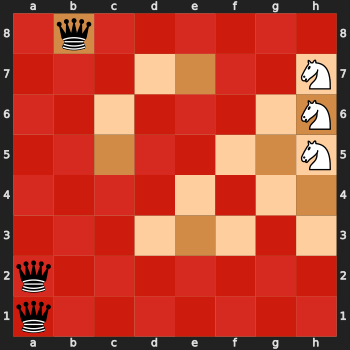MIP Knights
Introduction
I play a bit of chess and enjoy solving chess problems, so when someone showed me this problem writen by the chess grandmaster Ben Finegold 1 I first had a go at solving it (manually) and then wondered if I could phrase it as a mixed integer programming (MIP) problem. Turns out you can!
The rules of problem are as follows:
- Throughout the problem a white queen stays unmoved on the D5 square
- A black knight, which can move, starts off on the H8 square,
- The knight is not allowed to capture the queen,
- The knight moves around the board using standard chess knight move rules 2 but isn’t allowed to land on a square attacked by the queen at any point,
- To complete the game the knight has to land on every (un-attacked) square on the board, in sequence, moving from right to left along the eighth rank (H8, F8, E8, C8, B8) and then from right to left on the seventh rank (H7, G7, E7, C7, A7), and so on.
MIPs seem like a good fit for this since the problem is discrete and there is a clear objective function which can be expressed in integer terms - minimise the moves taken to complete the board.
TL;DR - just give me the code! See 3.
Building the general solver
The solver I built is actually a bit more general than the one needed to solve the problem in 1. It solves the problem:
“Taking
which easily collapses to the problem in 1 by taking
So how does the general solver work? We have three main variables in the model, all of which are binary:
The code has two additional variables,
Most of the constraints in the model are on
- At
- At no point in time can any knight have
- No two knights can share a square
And now the fun ones
- Each knight can be in at most one place on the board at each point in time. The interesting bit here is that the inequality is not strict, which allows the model to remove knights from the board when they are no longer needed (e.g. when all the squares have been visited by a knight). This trick lets us track the number of knight moves taken and minimise it. Gurobi’s
addConstsaccepts a python generator which lets us express a large number of constraints in one go:
model.addConstrs(
(
lp.quicksum(X[i, j, t, k] for i in range(N) for j in range(N)) <= 1
for t in range(T)
for k in range(K)
),
name="knights_one_square_at_a_time_each",
)
- Knight moves: This is effectively ‘conservation of knights’. We’re saying that at time, t, knight,
(i, j)if that same knight was one legal knights move away at time
model.addConstrs(
(
X[i, j, t, k] <= lp.quicksum(X[move_x, move_y, t - 1, k] for move_x, move_y in legal_moves(i, j, knight_moves, N))
for i in range(N)
for j in range(N)
for t in range(1, T)
for k in range(K)
),
name="legal_moves",
)
Finally, in order to track the timesteps we use the fact that if any knights are on the board at time,
model.addConstrs(
(
lp.quicksum(X[i, j, t, k] for i in range(N) for j in range(N)) <= Z[t]
for t in range(T)
for k in range(K)
),
name="timestep_tracking",
The sum of
Solving the general case model
We’re ready to solve it! The objective function is also configurable with three options:
- No objective function: Just try and find a feasible solution. It’s not very exciting but it solves really quickly,
- Minimise the number of knight moves: This and the next option are the same when there is only one knight, but gets interesting when we play with multiple knights…
- Minimise the number of time steps: Actually in this mode it’s a heirarchical optimisation. We first minimise the number of timesteps and then within that minimise the number of knight moves. Doing this makes the model realise that it can remove some knights from the problem early if it doesn’t need them.
Solving with the MINIMISE_TIME_STEPS objective:
import chess
from mip_knights.knight_problem import KnightProblem, ObjectiveChoice
knight_problem = KnightProblem(
[chess.H8],
[chess.D5],
objective_choice=ObjectiveChoice.MINIMISE_TIME_STEPS,
)
knight_problem.solve()
print(knight_problem.get_number_of_moves())
>>> 46

Solving the Finegold problem
As explained above we can now express the original Finegold problem as a series of these problem stitched together.
In terms of code there is a separate class, KnightTransportProblem, which derives from the KnightProblem but specialises to solving the A-to-B knight problem for a single knight. The FinegoldProblem class then holds and solves a chain ofKnightTransportProblem.
import chess
from mip_knights.finegold_problem import FinegoldProblem
finegold = FinegoldProblem()
finegold.solve()
print(finegold.get_number_of_moves())
>>> 158

Making it fancier…
Apparently very good chess players can solve the Finegold problem pretty easily (it took me a fair while!). But the MIP solver can do fancier things like:
- Solving boards quicker using multiple knights and teamwork,
- Solve harder boards with multiple queens
- Solving different initial conditions,
- Finding the initial positions for
For instance:

which is cool because the interaction between the knights is, I think, quite a bit harder to reason about when planning an optimal route for solving the problem.